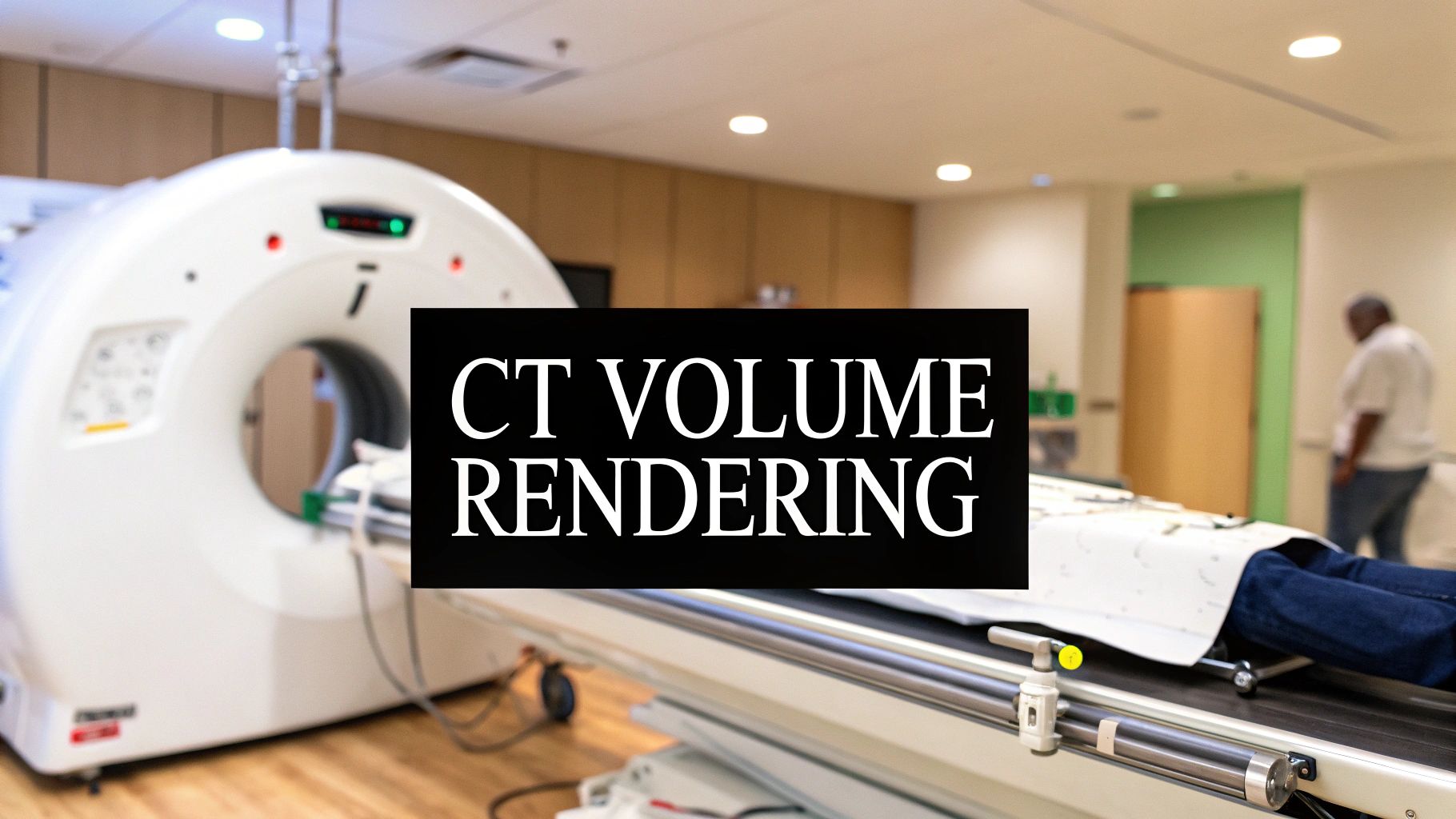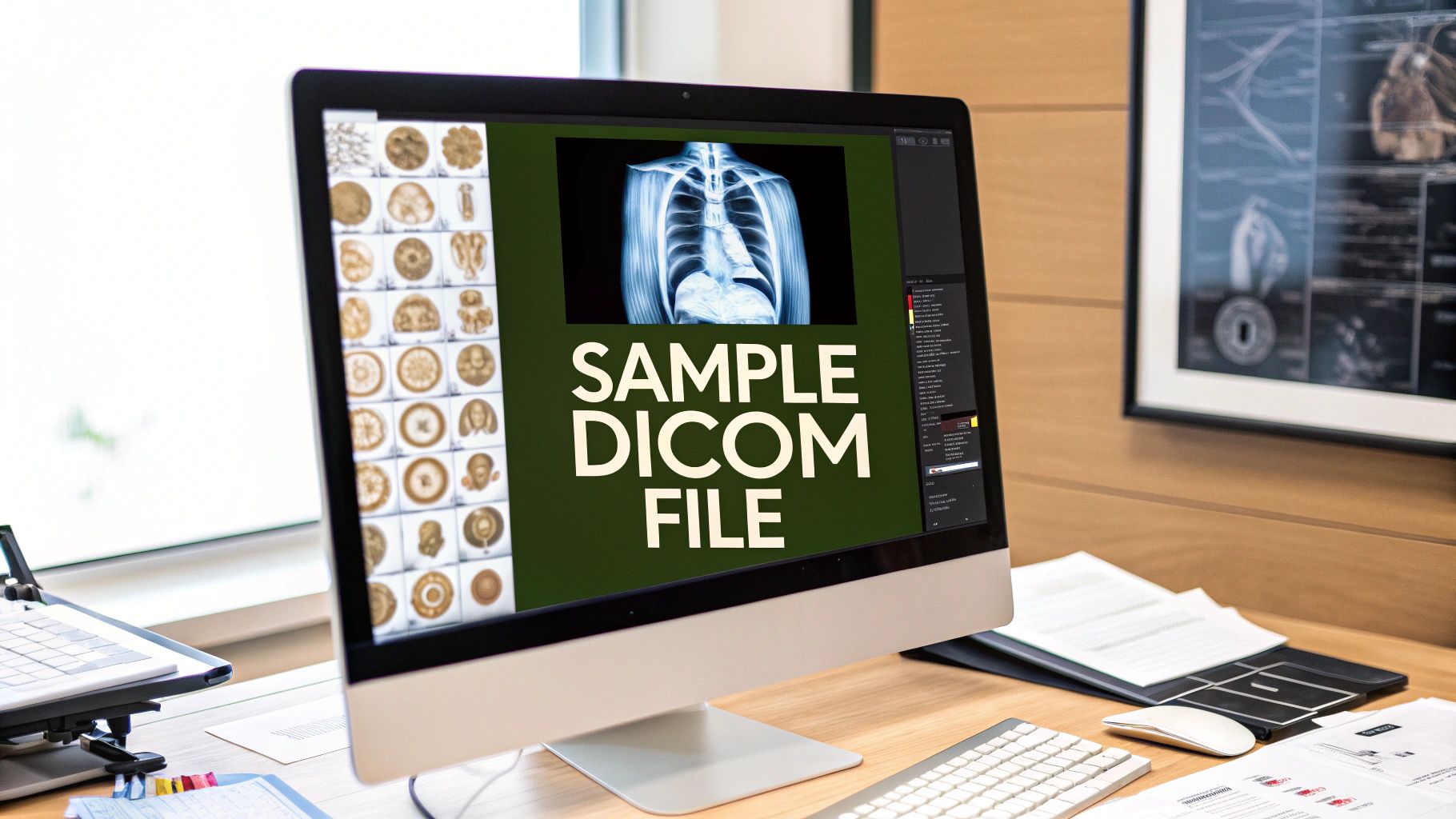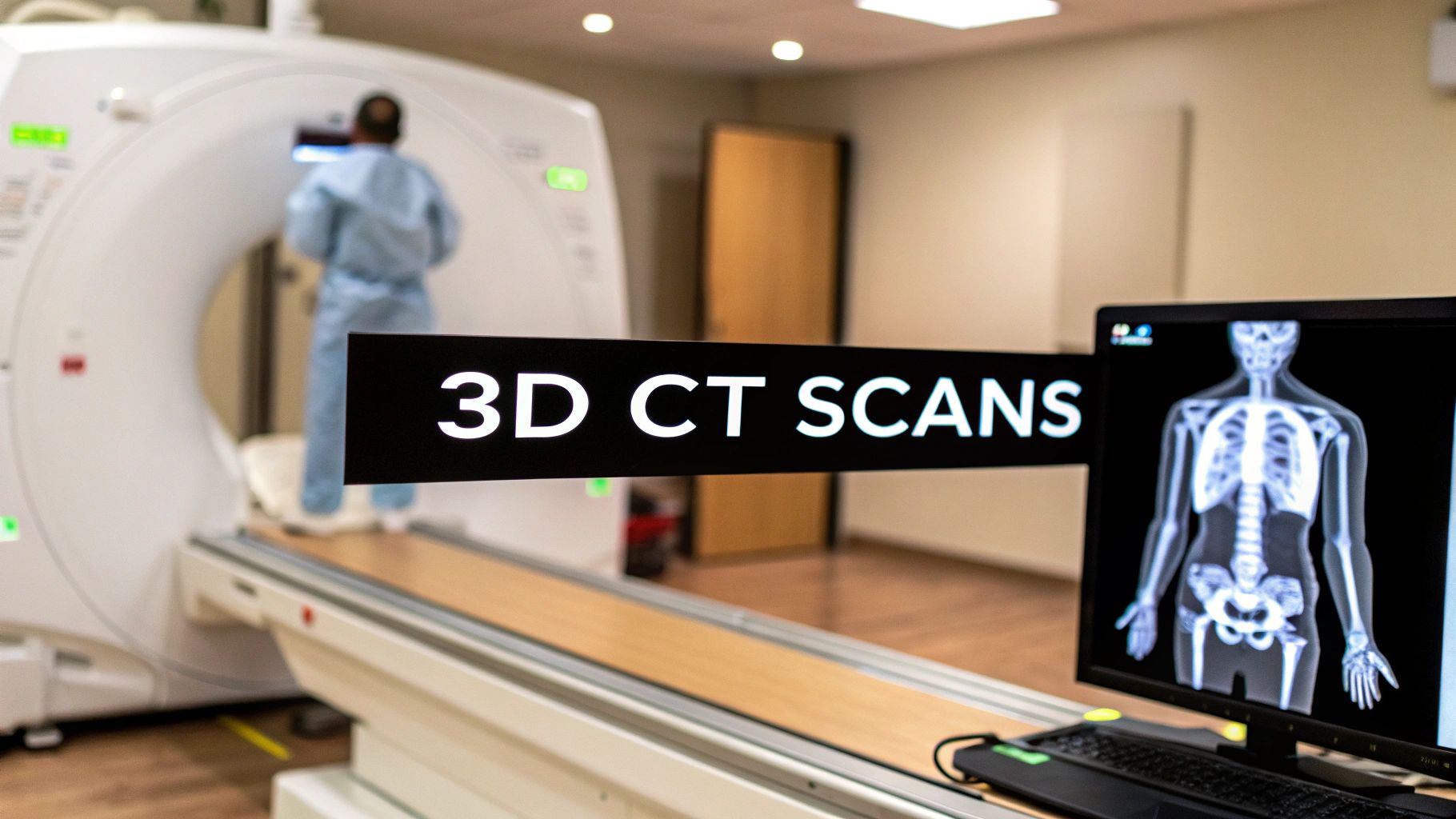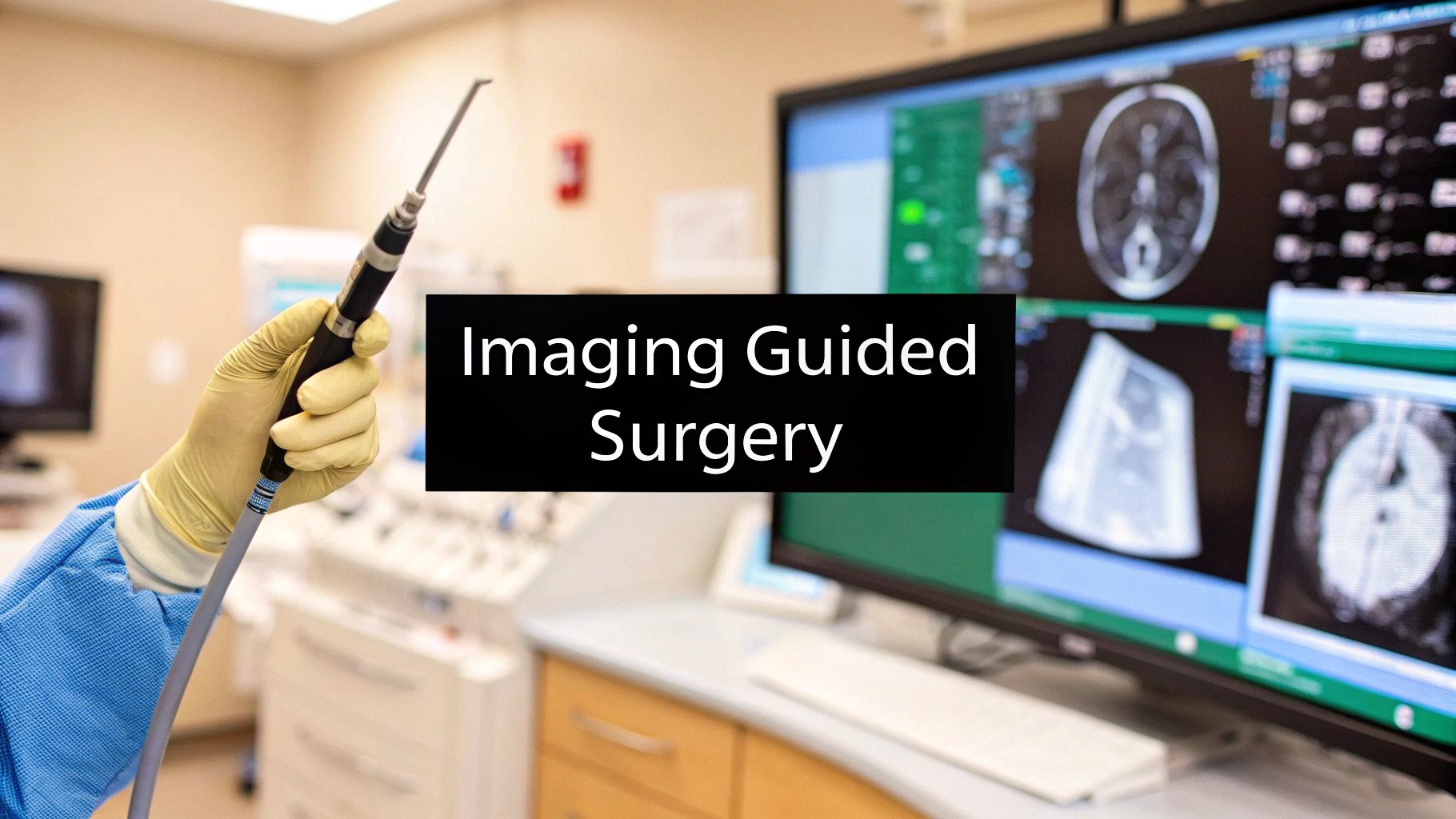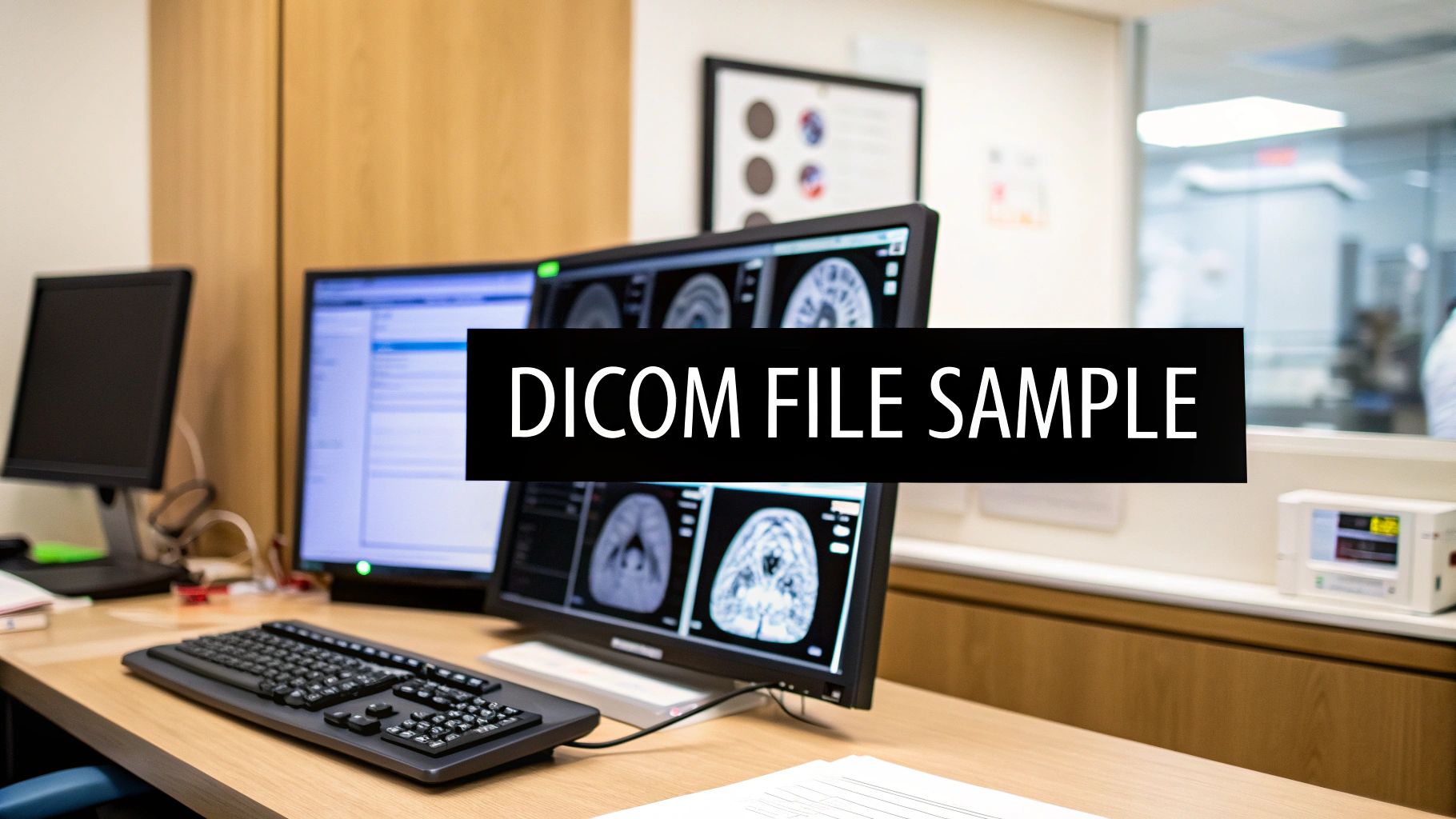CT Volume Rendering: Breaking Down the 3D View
CT volume rendering is changing how medical professionals visualize the human body. This technique takes two-dimensional grayscale slices from a CT scan and reconstructs them into interactive, three-dimensional models. These 3D visualizations reveal important anatomical details previously hidden within stacks of 2D images, giving clinicians a much deeper understanding of a patient's anatomy. This shift moves the field away from static images and towards dynamic exploration.
From Grayscale to 3D: The Development of Volume Rendering
The progress of CT volume rendering has been remarkable. Early renderings were basic, but advancements in technology have resulted in increasingly sophisticated and realistic models. Today, these 3D images offer incredibly detailed representations, enabling clinicians to virtually “rotate” and “dissect” organs, bones, and soft tissues. This detailed inspection improves diagnostic confidence across various medical specialties. This wouldn't have been possible without parallel advancements in computing power and rendering algorithms. For instance, certain algorithms are now more effective for specific clinical situations, enhancing accuracy and diagnostic capabilities.
Comparing Volume Rendering to Other 3D Imaging Techniques
While other 3D imaging techniques exist, CT volume rendering is unique. This is mainly due to its ability to generate high-quality representations of complex structures, particularly those with varying densities. This includes bone, soft tissue, and vascular networks. As computing power increases, so does the accessibility and practicality of 3D volume rendering in clinical settings. Three-dimensional volume rendering has become a key technique in medical imaging, offering significant advantages over traditional methods like shaded surface display and maximum intensity projection. It delivers detailed 3D visualizations that improve the understanding of complex anatomical structures and their relationships. Volume rendering involves managing volume data through acquisition, resampling, and editing, and applying various rendering parameters. Learn more about the advantages of volume rendering.
Advantages of Using CT Volume Rendering
The benefits of using CT volume rendering in medical practices are numerous:
-
Improved Diagnostic Accuracy: The ability to visualize anatomy in 3D often reveals subtle abnormalities that might be missed in traditional 2D scans.
-
Enhanced Surgical Planning: Surgeons can use these 3D models to plan procedures carefully, resulting in greater precision and reduced risk.
-
Better Patient Communication: Volume-rendered images allow for clearer communication between doctors and patients, improving shared decision-making and treatment adherence.
-
Comprehensive Image Evaluation: The “fly-through” and “fly-around” capabilities of volume rendering, supported by increasing computing power, allow for a more thorough image evaluation. These techniques are essential for a complete understanding of complex anatomical structures and contribute to accurate diagnoses.
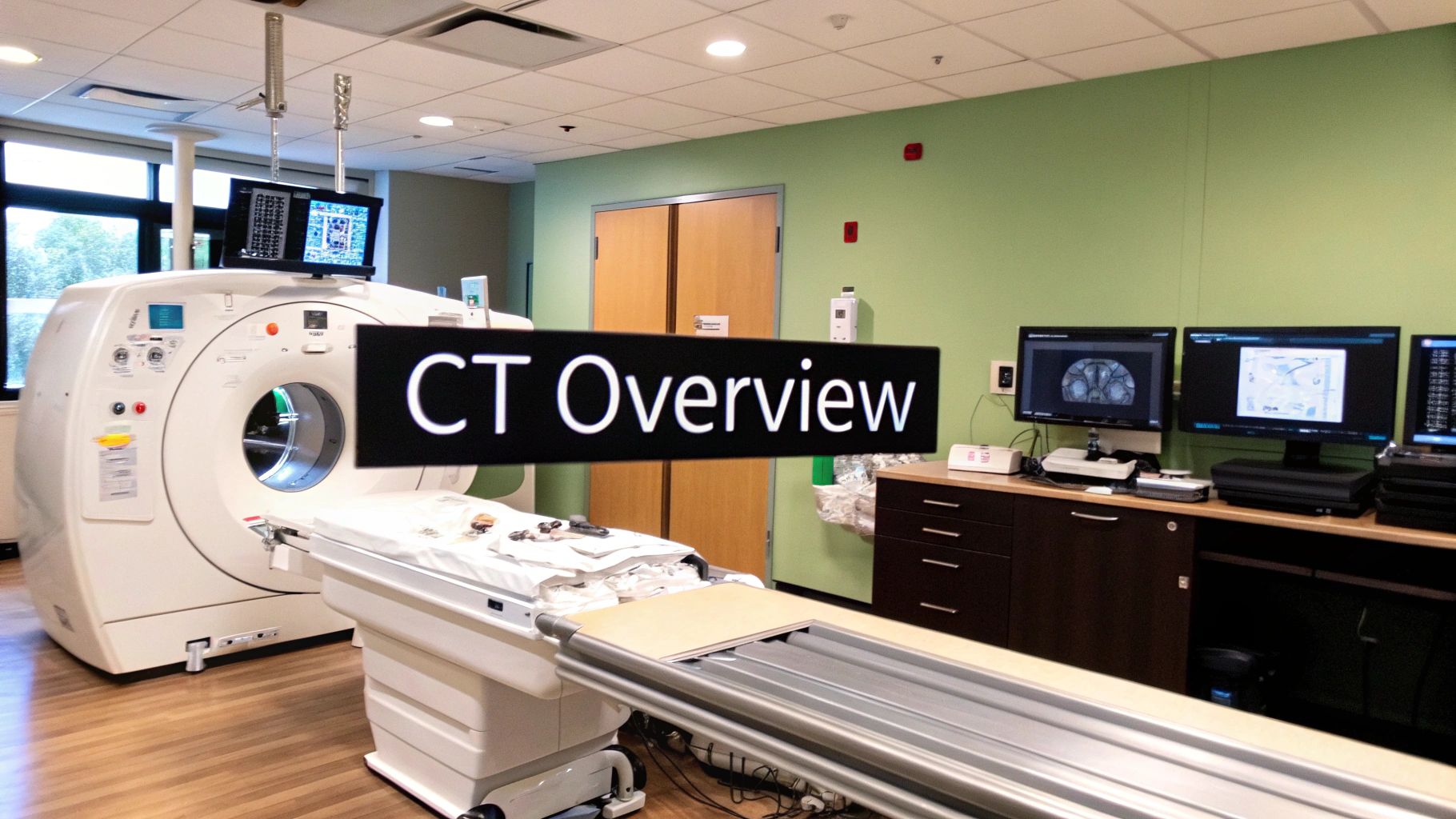
CT volume rendering is a significant advancement in medical imaging. Its ability to transform complex data into intuitive 3D representations is improving diagnostic accuracy, supporting surgical planning, and enhancing patient care across various specialties. As technology continues to develop, the applications and impact of CT volume rendering will only continue to grow.
How MDCT Technology Transforms CT Volume Rendering
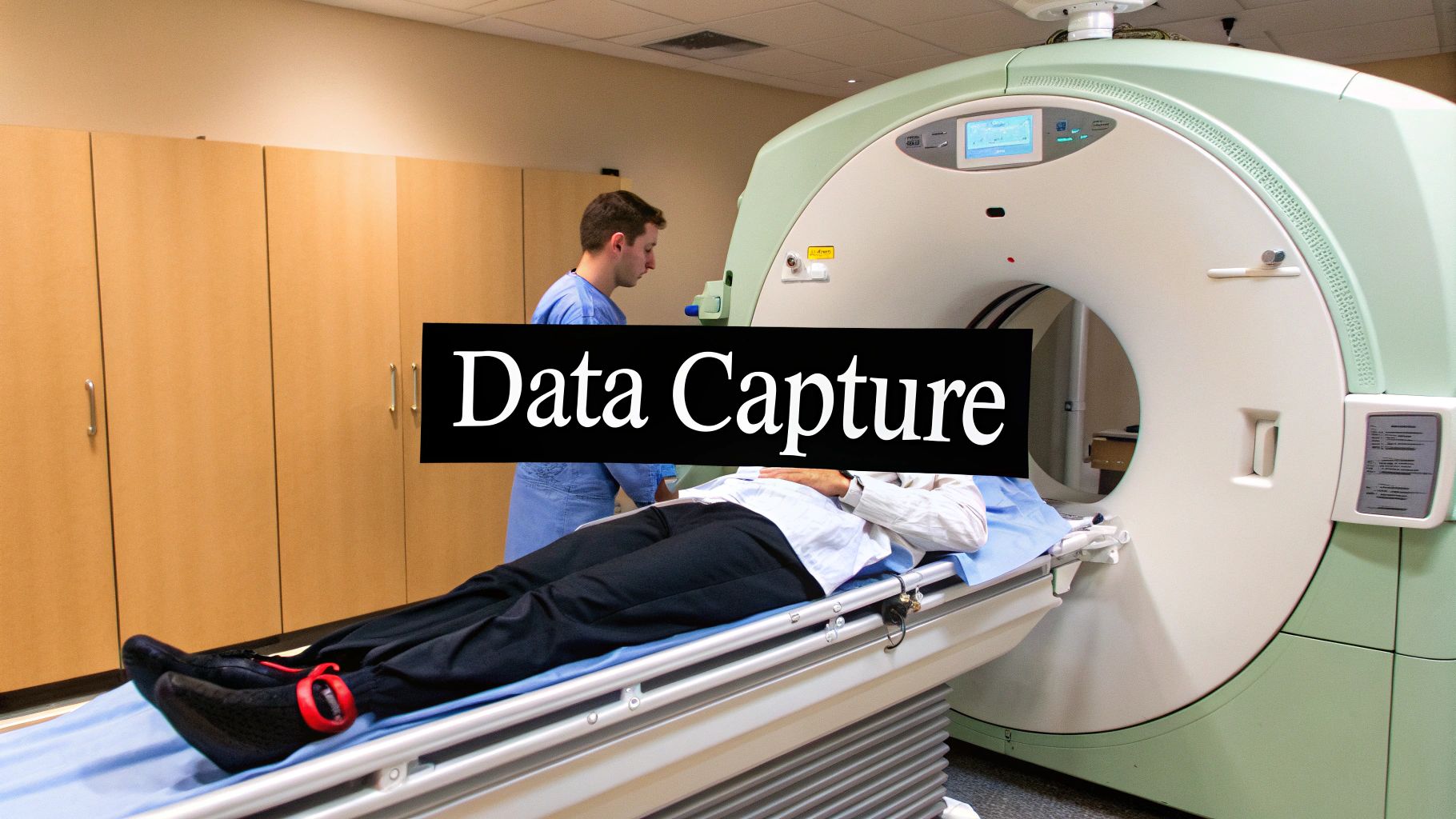
Multi-detector computed tomography (MDCT) has significantly changed how we approach CT volume rendering. It has greatly improved the speed and precision of 3D visualization creation. This allows clinicians to interact with highly detailed anatomical models in unprecedented ways. Let's explore how MDCT has achieved this.
Isotropic Imaging: The Foundation of Accurate 3D
A key advantage of MDCT is its ability to produce isotropic data. Isotropic imaging creates 3D images with equal resolution in all dimensions. Think of it like using perfectly square pixels, instead of rectangular ones, to create a digital image. Isotropic data allows rendered images to be rotated and viewed from any angle without any loss of important detail, which is crucial for accurate diagnosis and surgical planning. Previous limitations in image resolution made accurate reconstructions difficult.
Sub-Millimeter Precision: Capturing Fine Details
MDCT scanners acquire images with sub-millimeter slice thicknesses. This allows for remarkably precise 3D reconstructions. Imagine visualizing the delicate branches of the bronchial tree or the complex network of blood vessels with exceptional clarity. This detail gives clinicians valuable information for diagnosis, treatment planning, and patient education. Such granularity was simply not possible with older, single-slice CT technology.
Faster Acquisitions: Expanding Clinical Applications
The speed of MDCT has also significantly expanded the use of CT volume rendering. Faster scan times minimize motion artifacts, especially important for cardiac and pediatric imaging where patient movement can be a problem. Scans that once took minutes are now completed in seconds. This has created new opportunities for using CT volume rendering in previously challenging areas. The higher spatial resolution of MDCT allows for the creation of high-quality 3D images. Find more detailed statistics from the American Journal of Roentgenology.
Optimizing Scan Protocols For Volume Rendering
To get the most from CT volume rendering, scan protocols must balance image quality with radiation dose. Several factors contribute to this optimization:
- Slice Thickness: Thinner slices offer more detail but increase the radiation dose.
- Reconstruction Kernel: Specific kernels can be used to optimize image quality for various tissue types.
- Field of View: The right field of view minimizes artifacts and improves overall image quality.
By carefully adjusting these parameters, clinicians obtain the best CT volume rendering images while minimizing patient radiation exposure. This leads to more accurate diagnoses, better treatment plans, and improved patient care. It solidifies CT volume rendering as a powerful tool in medical imaging.
To understand the advancements in CT technology over time and their impact on volume rendering, consider the following table:
The table below, "Evolution of CT Scanner Technology," compares different generations of CT scanners and their impact on volume rendering capabilities.
| Scanner Type | Detector Configuration | Acquisition Speed | Resolution | Volume Rendering Quality |
|---|---|---|---|---|
| 1st Generation | Single detector, translate-rotate | Slow (minutes) | Low | Limited |
| 2nd Generation | Fan beam, translate-rotate | Moderate (seconds) | Moderate | Improved |
| 3rd Generation | Fan beam, rotate-rotate | Faster (sub-second) | Moderate | Good |
| 4th Generation | Stationary ring of detectors | Fast (sub-second) | High | Very Good |
| MDCT | Multiple detectors, rotate-rotate | Very Fast (milliseconds) | High | Excellent |
As you can see from the table, the evolution from single detector scanners to MDCT has resulted in dramatic improvements in acquisition speed and resolution, directly impacting the quality and clinical utility of volume rendered images. This allows for faster and more accurate diagnoses, leading to better patient outcomes.
Breaking Hardware Barriers in CT Volume Rendering
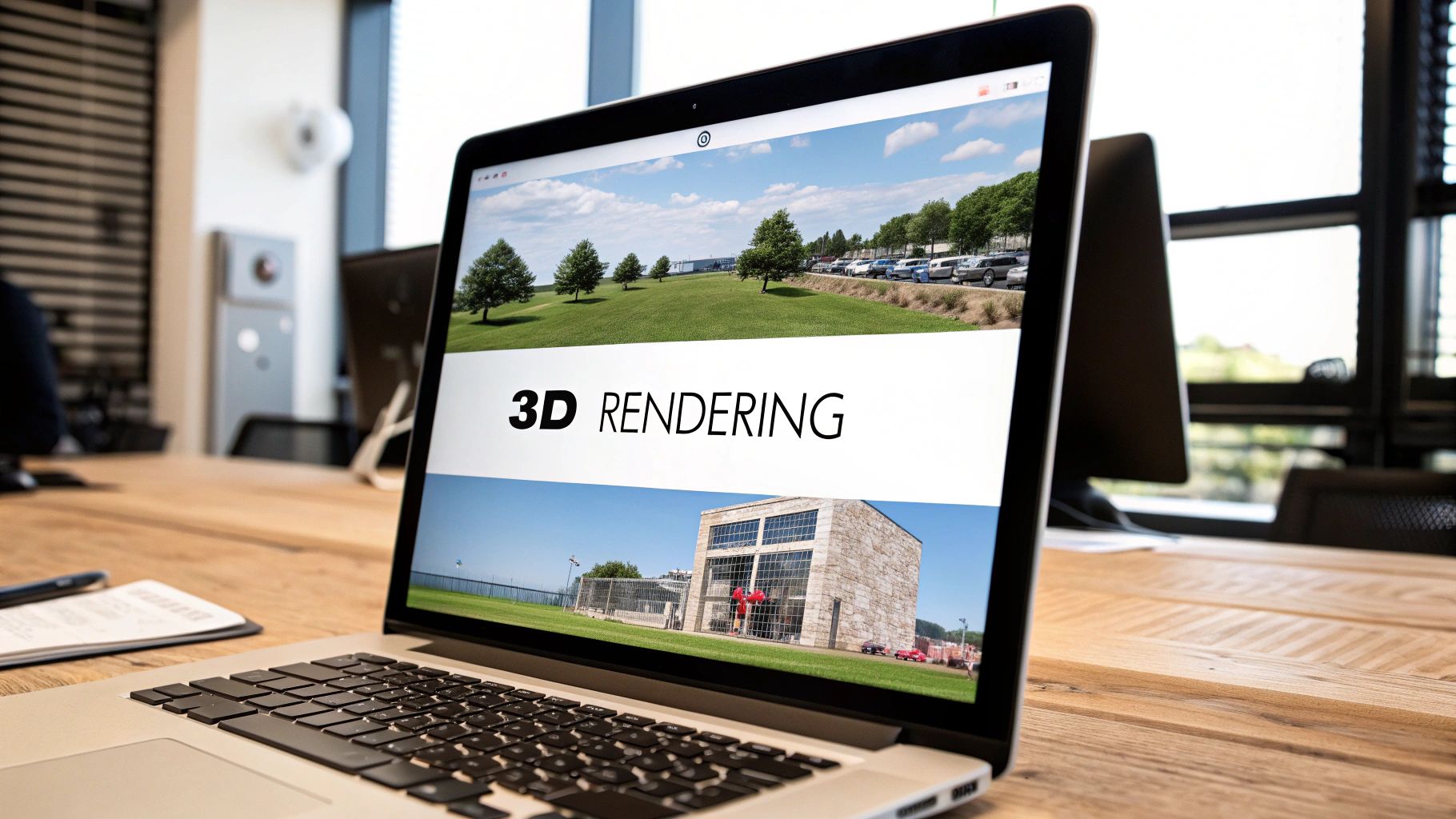
The advancements in CT volume rendering have been closely tied to progress in hardware capabilities. Graphics Processing Units (GPUs) have become indispensable for managing the substantial computational demands of interactive 3D visualization. This section explores how these hardware advancements have made real-time CT volume rendering a practical reality in clinical settings.
GPUs: The Engine Behind Real-Time Rendering
Modern GPUs are designed for parallel processing, making them well-suited to the complex calculations needed for CT volume rendering. They handle the large datasets from MDCT scanners with ease, allowing for smooth, interactive manipulation of 3D models.
Manipulating virtual organs in real-time—rotating, zooming, and dissecting—requires substantial processing power. GPUs excel at this, empowering clinicians to gain deeper anatomical insights.
Memory Management and Compression: Handling Gigabyte-Sized Datasets
CT scans often generate massive datasets, frequently exceeding available GPU memory. This poses a challenge for real-time rendering. However, advancements in memory management and compression algorithms address this issue.
These techniques allow for efficient handling of these large datasets, ensuring smooth and interactive visualizations. This is especially important in time-sensitive clinical situations where fast image analysis is critical.
Hardware-accelerated volume rendering, powered by advancements in GPUs, is now the standard for real-time visualization. Large datasets, however, still present a challenge. Volumetric compression with fast decompression offers a solution, enabling real-time compression and decompression without sacrificing image quality. This is critical in medical imaging where speed and accuracy are paramount for diagnosis and treatment planning. Explore this topic further.
Choosing the Right Hardware: Optimizing Performance and Value
Different clinical needs call for different hardware configurations. A high-end workstation with a powerful GPU and ample memory might be needed for complex visualizations like vascular reconstructions or surgical planning.
For routine diagnostic work, a less powerful setup may be sufficient. Understanding these nuances is key for selecting hardware that balances performance with value, catering to specific clinical requirements.
Emerging Technologies: Democratizing Access to Advanced Rendering
Beyond workstations, emerging technologies like cloud-based solutions are making advanced CT volume rendering more accessible. Clinicians can access and interact with 3D models on standard tablets and smartphones.
This extends the reach of CT volume rendering beyond specialized imaging centers, making it available in a wider range of settings. This is particularly helpful in underserved areas or for remote consultations.
Specialized Rendering Cards: Powering the Future
Specialized rendering cards designed specifically for medical imaging are pushing the boundaries of CT volume rendering. These cards provide even greater processing power and memory capacity.
This opens up new applications and techniques, such as real-time cinematic rendering, further improving diagnostic capabilities. This ongoing hardware evolution promises even more powerful and accessible CT volume rendering, ensuring clinicians have the tools for optimal patient care.
CT Volume Rendering That Changes Clinical Outcomes

CT volume rendering is more than just visually impressive; it has a direct impact on patient care and clinical outcomes. This technology empowers clinicians across various medical specialties to make more informed decisions, ultimately leading to better patient care.
Improving Surgical Outcomes Through Enhanced Visualization
CT volume rendering provides surgeons with a detailed anatomical "roadmap" of the patient. This comprehensive visualization significantly reduces procedural complications and improves overall surgical outcomes. For example, in complex vascular surgeries, the clear visualization of blood vessels allows for more precise navigation, minimizing the risk of accidental damage. This enhanced precision translates to shorter operating times, reduced blood loss, and faster recovery times for patients.
Applications Across Multiple Specialties
The versatility of CT volume rendering allows it to impact many areas of medicine. Vascular specialists utilize specific rendering techniques to confidently evaluate complex aneurysms and plan interventions. Orthopedic surgeons use the submillimeter precision of CT volume rendering for reconstructions, ensuring optimal implant placement and bone alignment. Oncologists also benefit from this technology, leveraging it to precisely measure tumor volume, assess treatment response, and refine radiation therapy plans. This level of detail enables more effective and personalized treatment strategies.
Optimizing Rendering Parameters for Specific Clinical Questions
The adaptability of CT volume rendering is a key strength. Clinicians can adjust rendering parameters such as opacity and color to highlight specific anatomical structures or pathologies. This customization enables the creation of visualizations that directly address the clinician's specific questions. A surgeon, for instance, might visualize only the bony structures in a fractured limb, while a vascular surgeon may focus on enhancing blood flow visualization within a particular vessel. This tailored approach provides the most relevant information at the point of care.
Patient Education and Treatment Adherence
Beyond diagnostics and surgical planning, CT volume rendering plays a vital role in patient education. The 3D visualizations simplify complex medical conditions, making them easier for patients to understand. When patients can visualize their own anatomy and grasp the reasoning behind their treatment plan, they become more actively involved in their care and are more likely to adhere to prescribed therapies. This active participation improves patient satisfaction and contributes to positive outcomes.
Emerging Trends: Volume Rendering and Virtual Reality
The future of CT volume rendering is full of exciting potential. Integration with virtual reality (VR) and augmented reality (AR) technologies is emerging as a valuable tool for surgical training and planning. Imagine surgeons being able to "rehearse" a complicated procedure in a virtual environment before operating on a patient. This level of preparation can significantly improve procedural proficiency and minimize risks associated with complex surgeries. These advancements promise to further enhance precision, minimize invasiveness, and ultimately lead to improved patient outcomes.
Achieving Measurement Precision in CT Volume Rendering
When accurate measurements are critical for clinical decisions, the precision of data taken from CT volume rendering becomes essential. This section delves into the elements impacting measurement precision in CT volume rendering and offers practical approaches for ensuring dependable results.
Slice Thickness: A Critical Factor in Volumetric Accuracy
One of the most important factors influencing measurement precision in CT volume rendering is slice thickness. Thinner slices offer a greater number of data points, resulting in more accurate 3D reconstructions and, subsequently, more precise measurements.
This is particularly important for volumetric measurements where even minor inaccuracies can have significant clinical consequences. For instance, accurately measuring tumor volume is essential for cancer staging and monitoring treatment response.
Refining Scanning and Reconstruction Parameters
Beyond slice thickness, other scanning and reconstruction parameters also play a role in measurement precision. The reconstruction kernel, a mathematical algorithm used to process the raw CT data, influences image sharpness and detail. Choosing the appropriate kernel for the specific clinical task is vital for maximizing measurement accuracy.
Furthermore, factors like field of view and radiation dose should be carefully considered to achieve optimal image quality while minimizing patient exposure.
Measurement Validation: Ensuring Clinical Reliability
Validating measurements is essential for building confidence in the data obtained from CT volume rendering. One approach involves comparing measurements taken from volume-rendered images with those obtained using other validated methods, such as physical caliper measurements or measurements from traditional 2D CT images. This comparison helps determine the accuracy and reliability of volume rendering for specific clinical uses.
Statistical studies are key to understanding the accuracy of 3D volume rendering measurements. For instance, research on the influence of scanning parameters on 3D CT renderings of the mandible found that linear and angular measurements remained highly accurate despite variations in scanner parameters or rendering techniques. However, volumetric measurements were only accurate when using thinner CT slices (1.25 mm). This highlights how slice thickness significantly impacts the precision of volumetric measurements. Learn more about this research. Techniques like volume rendering (VR) and volume of interest (VOI) offer detailed surface models, crucial for precise measurements in medical imaging.
To further illustrate the impact of various CT protocols on measurement accuracy, let's examine the following table:
Measurement Accuracy by CT Protocol
| Protocol Parameters | Linear Measurement Accuracy | Angular Measurement Accuracy | Volumetric Measurement Accuracy | Clinical Reliability |
|---|---|---|---|---|
| Thin Slice (1.25mm), Standard Kernel | High | High | High | High |
| Thick Slice (5mm), Standard Kernel | High | High | Low | Moderate |
| Thin Slice (1.25mm), Smooth Kernel | High | High | Moderate | High |
| Thick Slice (5mm), Smooth Kernel | High | High | Low | Low |
This table demonstrates the importance of thin slice thicknesses for achieving high volumetric measurement accuracy. While linear and angular measurements remain robust across different protocols, volumetric measurements suffer significantly with thicker slices.
Understanding Confidence Intervals and Communicating Uncertainty
Measurements derived from CT volume rendering, like any measurement, have inherent uncertainties. Confidence intervals provide a range within which the true value likely falls, representing this uncertainty.
It’s crucial to understand and communicate these confidence intervals when reporting measurements in clinical reports or research papers. This transparency ensures the limitations of the measurements are acknowledged and clinical decisions are made with a realistic understanding of the associated uncertainties.
Practical Strategies for Enhanced Measurement Precision
To improve measurement precision in CT volume rendering, consider the following practical strategies:
- Optimize slice thickness: Use the thinnest slices possible within radiation dose limits.
- Select the appropriate reconstruction kernel: Balance sharpness with noise reduction for the specific clinical task.
- Validate measurements: Compare volume rendering measurements with established methods.
- Communicate confidence intervals: Include confidence intervals to reflect measurement uncertainty.
By implementing these strategies, clinicians can enhance the precision and reliability of measurements obtained from CT volume rendering, leading to more informed clinical decisions and better patient care.
CT Volume Rendering Anywhere: Mobile & Cloud Solutions
The medical imaging field is evolving. Clinicians no longer need expensive, high-powered workstations to perform CT volume rendering. Cloud-based solutions are increasing access to this technology, allowing medical professionals to view complex 3D anatomical models on readily available devices like tablets and smartphones.
The Rise of Thin-Client Architectures
This shift towards mobile accessibility is largely thanks to thin-client architectures. In this model, the complex processing of CT volume rendering occurs on a remote server. The generated 3D images are then streamed to the user's device, which primarily serves as a display and interface. This approach permits the use of standard mobile devices without impacting the quality or interactivity of the 3D visualization.
This efficient use of processing power has significant implications for teleradiology. Specialists can now conduct remote consultations with full rendering capabilities, providing expert opinions from anywhere with an internet connection. This facilitates faster diagnoses and treatments, particularly in areas with limited access to specialized medical facilities.
Remote volume rendering pipelines address challenges related to large medical imaging datasets. Traditional rendering and transmission methods can be slow because of data size. Thin-client architectures, where data is stored and rendered on a server before streaming to mobile devices, use server power for high-performance rendering while utilizing the mobile device for display. Explore this topic further.
Implementing Mobile and Cloud Rendering Solutions
While conceptually straightforward, implementing these systems involves practical considerations. Bandwidth requirements are a main concern. Streaming high-resolution 3D images requires a strong, reliable internet connection.
Security is also crucial. Patient data confidentiality must be maintained throughout the process, necessitating robust encryption and access control measures.
Latency, the delay between user interaction and image response, can affect the efficacy of remote rendering. Optimizing the system to minimize latency is critical for a seamless and interactive experience.
Success Stories: From Academic Centers to Rural Hospitals
Despite these challenges, mobile and cloud-based CT volume rendering solutions are being successfully deployed. Major academic medical centers are using these tools to enhance collaboration and remote consultations.
Rural hospitals are also adopting these technologies to access specialist expertise, boosting the quality of care in underserved communities. These examples show the potential of these technologies to enhance healthcare access and quality.
Balancing Performance and Budget
Choosing specific solutions depends on balancing performance needs and budget constraints. Some institutions may select a fully cloud-based system, while others may prefer a hybrid approach with local servers and cloud resources.
Factors like the number of scans, the needed interactivity level, and existing IT infrastructure influence this decision. Careful planning and expert consultation can help identify the most appropriate approach for each institution.
The Future of CT Volume Rendering Accessibility
The ongoing development of mobile and cloud technology promises to further democratize access to CT volume rendering. As bandwidth increases and latency decreases, more sophisticated rendering techniques will become available on mobile devices.
This evolution will enable more clinicians to utilize 3D visualization, improving diagnoses, treatment planning, and ultimately, patient care.
The Future of CT Volume Rendering Is Already Here
CT volume rendering is no longer a thing of the future. Advancements in artificial intelligence (AI), rendering techniques, and mixed reality are changing medical visualization. These innovations offer real clinical promise, transforming how medical professionals interact with and understand a patient's anatomy.
AI-Assisted Segmentation: Automating the Tedious
AI plays a growing role in CT volume rendering, especially in segmentation. Traditionally, this manual and time-consuming process involved isolating specific structures within a 3D model. Imagine meticulously "coloring in" different parts of a complex anatomical illustration. Now, deep learning algorithms within AI software such as PyTorch can automate this task. This frees up clinicians' time and can potentially increase accuracy. For example, AI can automatically segment the liver from surrounding tissues in an abdominal CT scan, simplifying visualization and analysis.
Photorealistic Rendering: Visualizing with Unprecedented Realism
Cinematic rendering, adapted from techniques used in Hollywood, brings unprecedented realism to CT volume rendering. This approach adds realistic lighting, shadows, and textures to 3D models, making them appear almost photographic. This enhanced realism isn't just for aesthetics; it improves structure identification and helps clinicians understand spatial relationships within the body. This is especially helpful in complex surgeries requiring precise differentiation between tissues.
Mixed Reality: Bridging the Virtual and Real Worlds
Integrating CT volume rendering with virtual reality (VR) and augmented reality (AR) creates exciting possibilities for surgical planning and training. Surgeons can rehearse complex procedures in immersive VR environments, familiarizing themselves with patient-specific anatomy and practicing surgical techniques before operating. AR overlays volume-rendered images onto the real world, giving surgeons real-time "X-ray vision" during procedures, increasing precision and potentially reducing complications.
Preparing for the Future of CT Volume Rendering
While these advancements offer immense potential, it's important to distinguish true clinical value from hype. Not every emerging technology will significantly impact patient care. Focusing on technologies with proven clinical benefits and validated by research is critical. Investing in the necessary hardware and software infrastructure and training clinicians to use these new tools effectively is also essential. This preparation will allow healthcare institutions to embrace the future of CT volume rendering and provide optimal patient care.
Ready to integrate the power of AI into your medical imaging workflows? PYCAD offers comprehensive AI solutions, from data handling and model training to seamless deployment. Visit PYCAD to learn more and transform your medical imaging capabilities.
